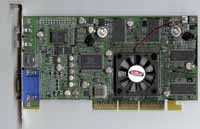
Original Link: https://www.anandtech.com/show/770
Not long after the ATI Radeon SDR began to appear on store shelves, a new and mysterious ATI product began to find its way into some e-stores. Bearing the inventory label of the Radeon LE, the product name was unrecognized by both members of the press as well as ATI themselves. Businesses selling the product proclaimed it a slightly slower version of the Radeon DDR that could be had at a price much sweeter than that of the Radeon DDR. As rumors surrounding the product spread like wild fire, it was only natural that customers remained wary of the "unannounced" card. There were, however, a few brave souls who put down the initial price of around $100 to find out what exactly the Radeon LE was.
Those who ended up with the card were originally disappointed. Although the card featured the same memory and apparently the same chip as the Radeon DDR, it's performance was not up to par. Add to this the fact that only a passive cooling system is available and the card is only to be found on OEM markets, and it is easy to understand why it took some time before people attempted to investigate exactly what was behind the Radeon LE.
Luckily, a group of technical savvy users set out figure out what is actually behind the Radeon LE label. With ATI refusing to comment on the cards and their almost spontaneous appearance, a select group of people began posting to news groups their impressions of the Radeon LE. It was not long after that discussion groups like our own AnandTech Forums began to become filled with messages on how to make the $71 Radeon LE perform identically to a $139 Radeon DDR.
The directions remained, for the most part, reserved to those who know a good deal about video cards. Pair this problem up with the fact that there remains very little professional documentation on how the Radeon LE performs in its native as well as tweaked state, and it became clear that something had to be done. That is why today we bring you all the information you wanted to know but were afraid to ask about the Radeon LE, including how it performs out of the box, if it is possible to achieve Radeon DDR speeds with the card, and just exactly where Radeon LEs come from. Read on as we take you through the paces of the budget card that could.
A Bit of History
One of the most curious aspects of the Radeon LE is the dearth of information surrounding the card. Originally, there was no official information regarding the Radeon LE, which inevitably led to quite a bit of speculation. A quick phone call to ATI sorted out the problem, and put all the rumors to rest.
The Radeon LE card is not actually produced by ATI. When ATI found no space in their product line for a video card based off of Radeon cores that did not meet speed specification, they decided to sell these chips to a third party manufacturer who could do with them what they pleased. Althon Micro, the company that ended up with the non qualifying Radeon cores, decided to manufacture and sell video cards based on these chips and gave these cards the name Radeon LE.
ATI agreed to this arrangement, given one condition: that the Radeon LE cards would be sold in the Asian market only. Estimating a large demand for slightly slower and cheaper Radeon DDR cards in this market, ATI said that Althon Micro could sell Radeon LE cards at a lower clock speed than the Radeon DDR as long as ATI's powerful HyperZ technology was disabled on the card's BIOS. ATI figured that this would provide a card that would fit between the Radeon SDR and Radeon DDR in terms of performance and therefore would not encroach on their product line.
This is why the mysterious Radeon LE cards originally appeared only in Asia. Unfortunately for Althon Micro, it was not long before they realized that the demand for a card like the Radeon LE was much lower than expected in this part of the world. Facing finical difficulties, ATI agreed to allow the sale of Radeon LE cards to the rest of the world as long as they were sold only in OEM packages.
And that brings us to where we are today. The Radeon LE can be found in a variety of on-line retailers, however it will always come in a nondescript brown box without a manual and will never appear on store shelves.
Just what will be in that plain cardboard box? Well, if it looks like a Radeon DDR and talks like a Radeon DDR, it must be a Radeon DDR, right? Not quite.
The Card
A quick glance at both the Radeon DDR and the Radeon LE will reveal some striking similarities. The board PCBs are essentially identical, with the Radeon LE containing the silk-screen imprints of a number of components missing on the Radeon LE. Nearly all of the components not found on the Radeon LE but present on the Radeon DDR relate to the Radeon DDR's VIVO capabilities which the Radeon LE lacks. This includes the ATI Rage Theater chip to the right of the heatsink and fan and the two video outputs and single video input found on the Radeon DDR's base. And while the memory chips may look physically different, the Radeon LE uses the same DDR SDRAM that the Radeon DDR uses except for the fact that the LE version uses slower rated 6ns (166MHz) memory while the Radeon DDR uses faster 5.5ns (181MHz) chips. Also the same is the memory bus width, which remains at 128-bits, keeping it a step above the Radeon SDR and Radeon VE solutions.
In order to ensure that the Radeon LE does not infringe on the Radeon DDR's performance margin, the card comes clocked quite a bit lower than the Radeon DDR; 35MHz slower to be exact. The Radeon LE ships with a 148MHz clock speed for both the memory and the core. It is for this reason that the Radeon LE is able to get away with using lower rated 6ns (166MHz) DDR SDRAM chips.
Missing on the Radeon LE is the active cooling method that the Radeon DDR uses. Instead, the Radeon LE uses a larger heatsink only cooling setup; a setup which should not hinder performance at all, considering the fan on the Radeon DDR is almost unquestionably not needed and only added for aesthetic value.
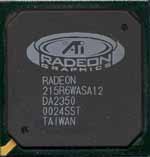 |
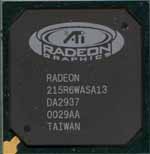 |
|
Radeon
LE Chip
|
Radeon
DDR Chip
|
Since the Radeon LE uses the exact same core as the Radeon DDR, it does not loose any of the Radeon DDR's powerful features except for one, but more on that in a minute. The Radeon LE, unlike the Radeon VE, still features ATI's T&L engine, the Charisma, running at the full core speed of 148MHz. This means that features like vertex skinning and keyframe interpolation are supported by the Radeon LE. The rendering pipeline count remains at two, each capable of processing 3 texels per second. Crunching the numbers gives us a theoretical fill rate of 888 megatexels per second and 296 megapixels per second at the 148MHz clock speed.
|
Video
Card Specification Comparison
|
||||||||
|
ATI
Radeon DDR
|
ATI
Radeon DDR OEM
|
ATI
Radeon LE
|
ATI
Radeon SDR
|
ATI
Radeon VE
|
||||
| Core |
Rage
6C
|
Mobile
Rage 6C
|
||||||
|
Clock Speed |
183MHz
|
166MHz
|
148MHz
|
166MHz
|
183MHz
|
|||
| Number of Chips |
1
|
1
|
1
|
1
|
1
|
|||
| Rendering Pipelines |
2
|
2
|
2
|
2
|
1
|
|||
| Texels/Clock |
3
|
3
|
3
|
3
|
3
|
|||
| Texels/Second |
1100
Million
|
996
Million
|
888
Million
|
996
Million
|
549
Million
|
|||
| Memory Bus |
128-bit
DDR
|
128-bit
SDR/DDR
|
128-bit
DDR
|
128-bit
SDR
|
64-bit
DDR
|
|||
| Memory Clock |
183MHz
DDR (366 MHz)
|
166
MHz DDR (333MHz)
|
148MHz
DDR
|
166MHz
SDR
|
183MHz
DDR (366MHz)
|
|||
| Memory Bandwidth |
5.8 GB/s
|
5.3 GB/s
|
4.7
GB/s
|
2.6
GB/s
|
2.9
GB/s
|
|||
| Manufacturing Process |
0.18-micron
|
|||||||
As a final note, don't worry about the Radeon LE loosing ATI's mainstay iDCT technology that greatly improves DVD playback: the Radeon LE features the same iDCT functions as the Radeon DDR. Also present is the same high quality 350MHz RAMDAC that ATI has become famous for.
So, besides the lower clock speed, which will obviously make a noticeable performance difference, what is the other feature left out of the Radeon LE that was hinted at before? Well, it is the lack of a portion of HyperZ technology. Although ATI's own website proclaims that "HyperZ technology ... [is] not in the Radeon LE" our tests have shown that not only does the Radeon LE come with fully functional HyperZ features, the Radeon LE arrives out of the box with HyperZ actually enabled in OpenGL but not in D3D. This must have seem like a perfect solution for ATI: cripple the card by lowering the clock speed and simultaneously slow the card down in D3D by disabling HyperZ features; but with all the similarities the card shares with the full fledged Radeon DDR, there must be some way around those pesky thorns in the Radeon LE's side.
Making it Faster
As Radeon LE owners quickly found out, altering the $71 Radeon LE to perform more like the $139 Radeon DDR was not as hard as ATI may have liked it to be.
The first, and easiest way to bring Radeon LE performance up to par was to simply overclock the card. Although the Radeon LE cores do come from Radeon DDR cores that do not quite make spec, the 148MHz core clock speed is most likely a bit conservative in almost every case. The majority of Radeon LE owners have had no problems hitting the OEM Radeon DDR core clock speed of 166MHz and a good number of owners have successfully overclocked their Radeon LE to the retail Radeon DDR clock speed of 183MHz.
The best way to go about overclocking a Radeon LE is to use an overclocking program like EnTech's PowerStrip which is available for download here. Since the Radeon's core and memory clock are synchronous (meaning they both must run at the same speed), overclocking the core any amount will also raise the memory clock speed. Don't worry though: the 166MHz DDR SDRAM chips used on the card should have no problem hitting their speced speed and with the good yields on SDRAM memory many chips will easily go higher.
On our Radeon LE card, a simple click of the mouse in PowerStrip allowed us effortlessly bring the Radeon LE's clock speed from 148MHz up to 183MHz without any problems. In fact, the Radeon LE's passive cooling system was sufficient enough to make the card stable as a rock at these high speeds.
Since HyperZ is, in fact, enabled in OpenGL on the Radeon LE cards, we speculated that raising the memory and core clock speeds up to 183MHz should make the card perform identically to the Radeon DDR in OpenGL games. D3D games, on the other hand, were a different story.
Working or not, the fact of the matter is that installing the Radeon driver set on a Radeon LE card will leave out the registry keys that enable HyperZ in Direct3D. It was not long before Radeon DDR owners began comparing their registry entries with Radeon LE owners and the differences were found.
Tweakers found that if the drivers detect a Radeon LE upon install, they leave out 3 registry keys used to control HyperZ in Direct3D. Without these keys present, HyperZ is disabled in Direct3D even though the HyperZ components are fully functional. Luckily, a simple registry hack can alleviate this problem.
The keys not present upon a Radeon LE install are all located in the [HKEY_LOCAL_MACHINE\Software\ATI Technologies\Driver\0000\atidxhal] key in the registry. Keep in mind that the "0000" key may be different on each machine, depending on how many other ATI video cards have been in the system. If the "atidxhal" subkey is not present in 0000, check for it in another key (0001, 0002, and so forth) and use that key instead.
To enable HyperZ in Direct3D mode, the following strings must be added to the atidxhal key in the registry. The keys to be added are: "FastZClearEnabled" with a value of 1, "DisableHierarchicalZ" with a value of 0, and "DisableHyperZ" with a value of 0.
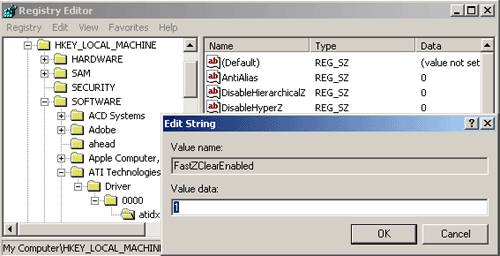
Once the above strings are in the registry, HyperZ will be enabled in Direct3D.
So, in theory, all it really takes is two easy steps to bring the Radeon LE performance up to the par of the Radeon DDR. Naturally, we can not grantee that the above methods will work on every Radeon LE card, since overclocking success will vary from chip to chip as well the reliability of HyperZ according to ATI. We do know, however, that our Radeon LE had no problems with the above tweaks, even when going to a 183MHz core and memory speed.
So, just how does the Radeon LE perform in its native and tweaked states. Let's find out.
The Drivers
The Radeon LE works with the same driver base as the rest of the Radeon series cards. In this review, we used the latest ATI supplied Radeon drivers, version 4.13.7103. For more information on the Radeon drivers, see our ATI vs NVIDIA: Driver performance under Win98 & Win2K article.
The Test
|
Windows 98 SE Test System |
|||||||
|
Hardware |
|||||||
| CPU(s) | AMD Athlon (Thunderbird) 1.33GHz | ||||||
| Motherboard(s) | ASUS A7M266 | ||||||
| Memory | 128MB PC2100 Corsair DDR SDRAM | ||||||
| Hard Drive |
IBM Deskstar DPTA-372050 20.5GB 7200 RPM Ultra ATA 66 |
||||||
| CDROM |
Phillips 48X |
||||||
| Video Card(s) |
ATI
Radeon SDR 32MB Hercules/Guillemot 3D Prophet 4500 NVIDIA
GeForce2 MX400 64MB SDR |
||||||
| Ethernet |
Linksys LNE100TX 100Mbit PCI Ethernet Adapter |
||||||
|
Software |
|||||||
|
Operating System |
Windows 98 SE |
||||||
| Video Drivers |
|
||||||
|
Benchmarking Applications |
|||||||
| Gaming |
idSoftware
Quake III Arena 1.27g - demo127.dm3 |
||||||
Note that due to the fact that none of the ATI Radeon cards tested would properly run Synetic's Mercedes-Benz Truck Racing demo, the benchmark was left out of this review.
OpenGL Performance - Quake III Arena

As ATI had hoped with the Radeon LE release, the product falls between the Radeon DDR and the Radeon SDR in terms of performance in its native state. Clocked at 148MHz, the Radeon LE outperforms the slightly more expensive ($73 Vs $71) Radeon SDR by slightly under 5%. Nothing to write home about, yet.
The Radeon LE really shines when overclocked. At 640x480x32, the Radeon LE clocked at 183MHz does just what we expect it to: perform identically to the Radeon DDR. The two cards perform within .3 FPS of one another, leaving the two cards almost indistinguishable from one another.
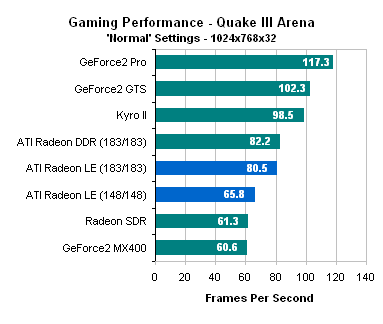
Once again, in its native state the Radeon LE falls between the Radeon DDR and the Radeon SDR in terms of performance. The Radeon LE scores slightly higher than its SDR brother, about 1% to be exact.
When overclocked, the Radeon LE does something that the Radeon SDR only wished it could do: perform like a Radeon DDR. At 1024x768x32, the Radeon LE at 183MHz performs only 2% slower than the Radeon DDR. The small differences in speed, which we will see throughout the benchmarks at higher resolutions, is probably caused by the slightly different way that the Radeon LE accesses the memory (mainly the memory timing set in the card's BIOS). Nonetheless, the 2% performance difference seems to be well worth the $68 difference in price, assuming that your Radeon LE can hit these speeds.
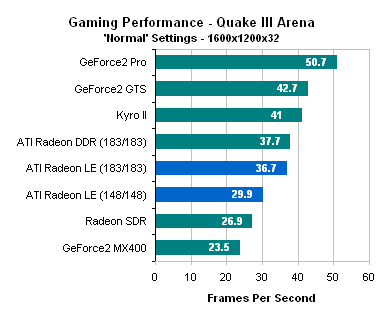
At 1600x1200x32, the Radeon DDR's extra memory bandwidth allows it to take a larger step away form the Radeon SDR. Here the card in its native state performs 11% faster than the Radeon SDR. At 30 FPS, however, the frame rate does leave something to be desired.
We find that overclocking the card, once again, reveals some pleasing results. The Radeon LE at 183/183MHz performs almost like a Radeon DDR, in fact the two are separated by only 1 FPS, a mere 3%. Contrast that to the 95% difference in price and it is easy to see why the Radeon LE may be the perfect card for those wishing to take a bit of a gamble.
Real-World Fillrate
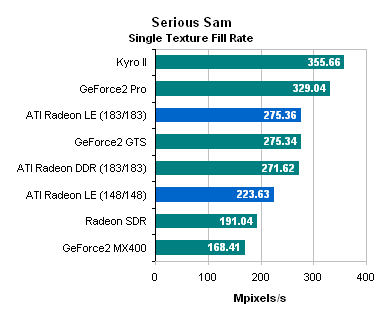
Naturally, with the Radeon LE coming clocked lower than the Radeon DDR, the fill rate of the card as measured in Serious Sam is less than that of the Radeon DDR. One interesting fact is that although the Radeon SDR theoretically has only a slightly lower fill rate than the Radeon DDR, yet it falls to the bottom of the chart, it is held back by its SDR memory bus.
Overclocking the card proves that the differences between the Radeon LE core and the Radeon DDR core are nonexistent. The two card perform nearly identically in terms of real world fill rate, also showing that HyperZ is enabled in OpenGL on the Radeon LE.
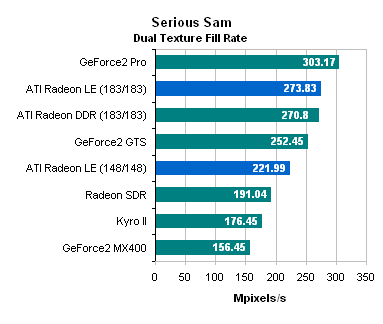
When measuring dual texture fill rates, the Radeon LE once again performs smack between the Radeon SDR and Radeon DDR in terms of performance. This leaves the Radeon LE performing quite a bit better than the Radeon SDR in dual texture fill rate measurements.
Overclocking the card to the 183MHz mark allows the Radeon LE to perform like a Radeon DDR yet again. Beginning to see a trend?
OpenGL Performance - Serious Sam
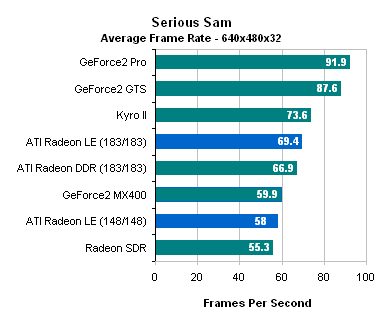
The trend continues in Serious Sam at 640x480x32, with the Radeon LE out of the box performing slightly faster than the Radeon SDR. A bit of tweaking, 35MHz of tweaking to be exact, reveals a card that is indistinguishable from the Radeon DDR, laying to rest the myths that the Radeon LE has no HyperZ functionality (no tweaking besides the increase in clock speed was performed on the Radeon LE).

At 1024x768x32, the Radeon LE performs essentially identical to the Radeon SDR out of the box and essentially like the Radeon DDR when overclocked.
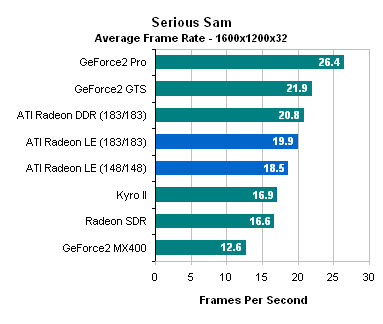
1600x1200x32 in Serious Sam paints a familiar picture. Not much explaining to be done.
DX7 Performance - Unreal Tournament
Unreal Tournament provided us with a Direct3D game with which to test the effectiveness of the Radeon LE's HyperZ capabilities once the appropriate registry keys had been added. In the following graphs, the bar labeled "ATI Radeon LE with HyperZ" refer to the standard Radeon LE card with HyperZ enabled. The "ATI Radeon LE (183/183)" bar represents the Radeon LE running at 183MHz with HyperZ enabled as well.
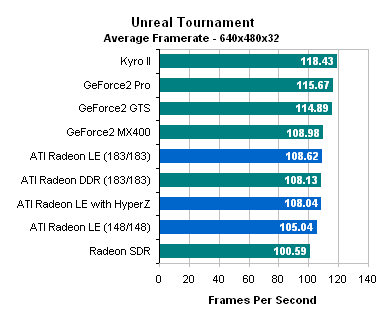
In Unreal Tournament at 640x480x32, essentially all the cards perform the same. It is interesting that the Radeon LE is actually able to gain more performance at this resolution by enabling HyperZ than by overclocking the card to 183MHz. This seems to accurately reflect the memory intensive nature of the Unreal engine, as HyperZ can provide significant improvement as we have already seen.
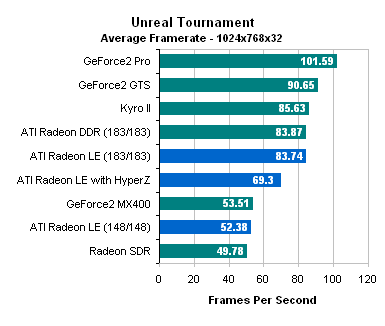
The Radeon LE performs nearly the same as both the Radeon SDR and the GeForce2 MX in Unreal Tournament at 1024x768x32. A bit of tweaking separates the card from the pack.
Enabling HyperZ provided a big boost for the Radeon LE at 1024x768x32. Simply adding the 3 registry keys described above allowed for a 32% performance increase. Add to this the 35MHz we overclocked the card and the Radeon LE gets new life, performing a full 60% faster than the standard Radeon LE. This brings the card's performance to Radeon DDR levels, as we have seen before.

With HyperZ disabled and a massive amount of data traveling over the memory bus at 1600x1200x32, the Radeon LE gets trumped by every other card tested. This is first alleviated by enabling HyperZ, allowing the Radeon LE to realize a 43% performance increase. When overclocked to Radeon DDR speeds, the card performs within 4% of the Radeon DDR and 75% faster than how it comes out of the brown box.
Conclusion
With a price lower than all but 2 video cards on this week's price guide, the ATI Radeon LE is by all means a budget video card. Although only available on-line, the brown box that the Radeon LE comes in is sure to please even those not necessarily looking for a budget video card.
Out of the box, the Radeon LE's performance is respectable, considering the price. The card barely outperformed the Radeon SDR in many of our tests, giving it a slight edge. This also left the card performing very close, if not higher, than NVIDIA's budget solution, the GeForce2 MX and MX 400 which runs for about $75 in a 32MB configuration. One thing that the Radeon LE has that the other cards in this price range do not is potential.
The potential of the Radeon LE is huge. Simply overclocking the card provided huge speed increases that could not be matched by overclocking the other cards. In addition, adding 3 simple strings to the registry provided huge gains in our D3D benchmark, Unreal Tournament. When overclocked to the 183MHz mark, the Radeon LE performed identically to the Radeon DDR in OpenGL games, showing that not only is the HyperZ component of the Radeon is present on the Radeon LE, it is also functioning. Although disabled in DirectX, that is easy to overcome with the aforementioned registry keys. Performing these tweaks leaves the Radeon LE trouncing all other "budget" cards.
A great value, there are some caveats to the Radeon LE. First off, overclocking success will undoubtedly vary. One must keep in mind that the Radeon LE cores are actually Radeon DDR cores that did not meet spec. This means that the chip on your Radeon LE may or may not hit speeds of 183MHz. In addition, the memory is only speced to 166MHz, so this provides another limitation in hitting the 183MHz mark. Rest assured that the vast majority of Radeon LE cards out there will overclock some above the very conservative 148MHz that they ship at. To what extent the card will overclock is really luck of the draw.
The second item to remain cautious of is a problem that is present in the whole Radeon series: the Radeon drivers. As we saw in our ATI vs NVIDIA: Driver performance under Win98 & Win2K article, the Radeon drivers are not up to par. Add to this the problem we encountered while running Synetic's Mercedes-Benz Truck Racing demo on the drivers we got from ATI's site and it is clear that the Radeon driver set is still not up to par.
As it turns out, the Radeon LE may be the perfect video card for the gamer looking to spend less that $100 on a card. If you are a user who does not mind taking risks, risks with both driver problems and problems hitting high overclocked speeds, than the Radeon LE is ideal for you. Plus, you can rest assured that the Radeon LE you just bought will perform at the same level or better as the comparably priced Radeon SDR, only with a lot more potential.


